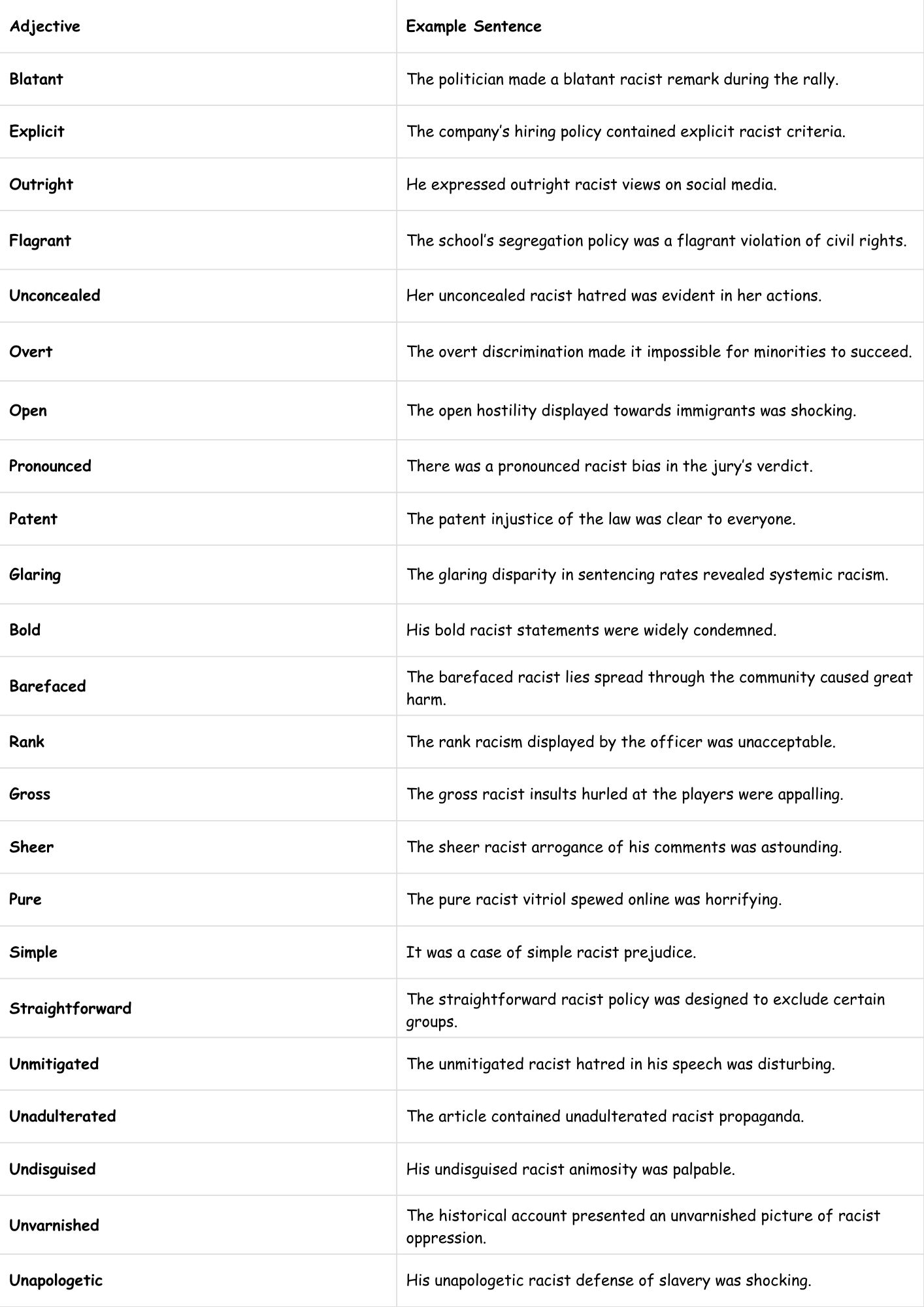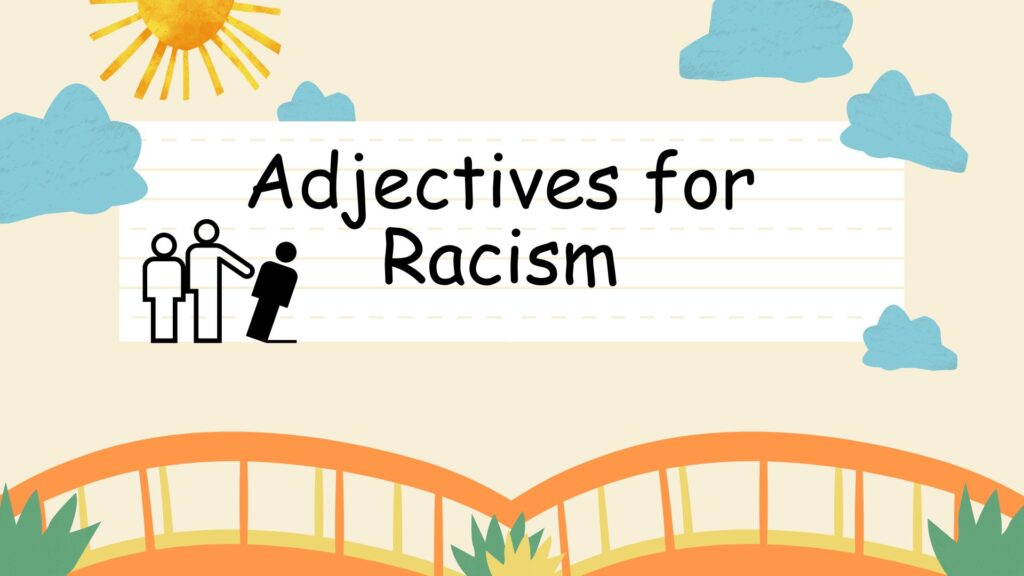Understanding and discussing racism requires a nuanced vocabulary. Choosing the right adjectives is crucial for accurately conveying the nature, scope, and impact of racist actions, policies, and beliefs. This article provides a comprehensive guide to adjectives related to racism, helping you to communicate more effectively and sensitively. Whether you’re a student, educator, journalist, or simply someone seeking to better understand this complex issue, this guide will equip you with the language tools you need.
This article explores the various types of adjectives used to describe racism, their specific meanings, and how to use them appropriately in different contexts. We’ll cover everything from overt expressions of prejudice to more subtle forms of discrimination, providing examples and practice exercises to solidify your understanding.
Table of Contents
- Definition of Adjectives for Racism
- Structural Breakdown
- Types and Categories of Adjectives for Racism
- Examples of Adjectives for Racism
- Usage Rules for Adjectives of Racism
- Common Mistakes When Using Adjectives for Racism
- Practice Exercises
- Advanced Topics
- Frequently Asked Questions
- Conclusion
Definition of Adjectives for Racism
Adjectives used to describe racism are words that modify nouns or pronouns to provide more specific information about the nature, characteristics, or effects of racist actions, beliefs, or systems. These adjectives help to clarify the type of racism being discussed, its intensity, and its impact on individuals and communities. They are essential for precise and nuanced communication about a sensitive and complex topic.
Racism, in its broadest sense, is prejudice, discrimination, or antagonism directed against someone of a different race based on the belief that one’s own race is superior. Adjectives help to break down this broad definition into specific instances and manifestations.
Structural Breakdown
Adjectives, in general, typically precede the noun they modify (a racist remark) or follow a linking verb (the policy is discriminatory). Adjectives related to racism follow the same structural rules as other adjectives in English grammar.
The structure often involves using a descriptive adjective before the noun to highlight the racist nature of the action or idea. For example:
- Racist policies
- Discriminatory practices
- Prejudiced attitudes
Additionally, adjectives can be part of more complex phrases to provide greater detail. For instance:
- A blatantly racist statement
- An unintentionally discriminatory effect
- A systemically biased institution
Types and Categories of Adjectives for Racism
Adjectives used to describe racism can be categorized based on the aspect of racism they highlight. Here are some key categories:
Overtly Racist Adjectives
These adjectives describe racism that is open, direct, and easily recognizable. They denote actions, beliefs, or statements that are explicitly based on racial prejudice or discrimination.
Examples include: blatant, explicit, outright, flagrant, unconcealed.
Covertly Racist Adjectives
These adjectives describe racism that is subtle, indirect, and often disguised. They refer to actions, policies, or beliefs that may appear neutral on the surface but have a discriminatory effect or reflect underlying racial bias.
Examples include: subtle, implicit, indirect, veiled, insidious.
Systemic Racism Adjectives
These adjectives describe racism that is embedded in the structures and institutions of society. They refer to policies, practices, and norms that, intentionally or unintentionally, perpetuate racial inequality.
Examples include: systemic, institutional, structural, entrenched, pervasive.
Attitudinal Racism Adjectives
These adjectives describe the attitudes, beliefs, and feelings that underlie racist behavior. They refer to the internal prejudices and biases that motivate discriminatory actions.
Examples include: prejudiced, biased, bigoted, discriminatory, intolerant.
Impact-Focused Adjectives
These adjectives describe the effects or consequences of racist actions or policies. They focus on the harm caused by racism, rather than the intent behind it.
Examples include: harmful, damaging, detrimental, oppressive, marginalizing.
Examples of Adjectives for Racism
This section provides extensive examples of adjectives used to describe racism, organized by the categories discussed above. Each table contains numerous examples to illustrate the diverse ways these adjectives can be used.
The following table shows examples of overtly racist adjectives.
| Adjective | Example Sentence |
|---|---|
| Blatant | The politician made a blatant racist remark during the rally. |
| Explicit | The company’s hiring policy contained explicit racist criteria. |
| Outright | He expressed outright racist views on social media. |
| Flagrant | The school’s segregation policy was a flagrant violation of civil rights. |
| Unconcealed | Her unconcealed racist hatred was evident in her actions. |
| Overt | The overt discrimination made it impossible for minorities to succeed. |
| Open | The open hostility displayed towards immigrants was shocking. |
| Pronounced | There was a pronounced racist bias in the jury’s verdict. |
| Patent | The patent injustice of the law was clear to everyone. |
| Glaring | The glaring disparity in sentencing rates revealed systemic racism. |
| Bold | His bold racist statements were widely condemned. |
| Barefaced | The barefaced racist lies spread through the community caused great harm. |
| Rank | The rank racism displayed by the officer was unacceptable. |
| Gross | The gross racist insults hurled at the players were appalling. |
| Sheer | The sheer racist arrogance of his comments was astounding. |
| Pure | The pure racist vitriol spewed online was horrifying. |
| Simple | It was a case of simple racist prejudice. |
| Straightforward | The straightforward racist policy was designed to exclude certain groups. |
| Unmitigated | The unmitigated racist hatred in his speech was disturbing. |
| Unadulterated | The article contained unadulterated racist propaganda. |
| Undisguised | His undisguised racist animosity was palpable. |
| Unvarnished | The historical account presented an unvarnished picture of racist oppression. |
| Unapologetic | His unapologetic racist defense of slavery was shocking. |

The next table provides examples of covertly racist adjectives.
| Adjective | Example Sentence |
|---|---|
| Subtle | The subtle racist undertones in the conversation made me uncomfortable. |
| Implicit | The study revealed implicit racist biases in the hiring process. |
| Indirect | The indirect racist policies disproportionately affected minority communities. |
| Veiled | The politician’s veiled racist remarks were disguised as economic concerns. |
| Insidious | The insidious racist stereotypes in the media contribute to systemic inequality. |
| Underlying | The underlying racist assumptions shaped the research findings. |
| Hidden | Hidden racist agendas influenced the decision-making process. |
| Disguised | The disguised racist practices were difficult to detect. |
| Latent | The community harbored latent racist sentiments. |
| Unconscious | The unconscious racist bias affected his judgment. |
| Tacit | There was a tacit racist agreement among the members. |
| Unspoken | The unspoken racist rules dictated social interactions. |
| Circumstantial | The circumstantial racist evidence was not enough for a conviction. |
| Alleged | The investigation into the alleged racist incident is ongoing. |
| Seemingly neutral | The seemingly neutral policy had a discriminatory impact. |
| Apparently unbiased | The apparently unbiased assessment revealed hidden prejudices. |
| Superficially fair | The superficially fair system perpetuated inequality. |
| Code | The speaker used code racist language to appeal to a specific audience. |
| Euphemistic | The euphemistic racist phrasing made it difficult to challenge. |
| Subliminal | The advertisement contained subliminal racist messages. |
| Under the radar | The under the radar racist activity continued unnoticed. |
| Quiet | Quiet racist prejudice was prevalent in the town. |
| Unacknowledged | The unacknowledged racist history continued to affect the present. |
The following table shows examples of adjectives describing systemic racism.
| Adjective | Example Sentence |
|---|---|
| Systemic | Systemic racist inequalities persist in the criminal justice system. |
| Institutional | The report highlighted institutional racist practices in the police department. |
| Structural | Structural racist barriers prevent minorities from accessing quality education. |
| Entrenched | Entrenched racist biases are difficult to overcome. |
| Pervasive | Pervasive racist attitudes permeate society. |
| Historical | Historical racist policies continue to shape the present. |
| Ingrained | Ingrained racist ideologies are passed down through generations. |
| Deep-rooted | Deep-rooted racist prejudices are hard to eradicate. |
| Widespread | Widespread racist discrimination limits opportunities for minorities. |
| Societal | Societal racist norms reinforce inequality. |
| System-wide | The audit revealed system-wide racist problems. |
| Built-in | There are built-in racist mechanisms in the legal framework. |
| Organizational | The organizational racist culture fostered discrimination. |
| Integrated | Integrated racist practices were part of everyday life. |
| Overarching | The overarching racist ideology influenced policy decisions. |
| Longstanding | The longstanding racist traditions continued to affect the community. |
| Rooted | The problem is rooted in racist assumptions. |
| Endemic | Endemic racist attitudes were common in the workplace. |
| Inherent | The inherent racist bias in the algorithm led to unfair outcomes. |
| Imbedded | Imbedded racist narratives were prevalent in textbooks. |
| Structural | Structural racist inequalities affect access to healthcare. |
| Societal | Societal racist attitudes are difficult to change. |
| Culturally sanctioned | The culturally sanctioned racist practices were harmful. |
The table below gives examples of Attitudinal Racism Adjectives.
| Adjective | Example Sentence |
|---|---|
| Prejudiced | The manager showed prejudiced behavior towards his minority employees. |
| Biased | The study revealed biased attitudes among the participants. |
| Bigoted | His bigoted remarks were offensive and unacceptable. |
| Discriminatory | The company’s discriminatory hiring practices were illegal. |
| Intolerant | The intolerant views expressed by the speaker were widely criticized. |
| Racially charged | The racially charged atmosphere made many people uncomfortable. |
| Racially insensitive | His comments were considered racially insensitive. |
| Hateful | The website promoted hateful racist ideologies. |
| Xenophobic | The politician’s xenophobic rhetoric fueled discrimination against immigrants. |
| Sexist | His sexist and racist remarks were appalling. |
| Narrow-minded | Her narrow-minded racist views were out of touch. |
| Ethnocentric | The ethnocentric racist worldview caused misunderstandings. |
| Insular | The insular racist community was resistant to change. |
| Parochial | His parochial racist assumptions were limiting. |
| Opinionated | His opinionated racist beliefs were unwelcome. |
| Judgmental | Her judgmental racist attitude created tension. |
| Condescending | His condescending racist tone was offensive. |
| Paternalistic | The paternalistic racist approach was outdated. |
| Superior | His superior racist attitude was arrogant. |
| Arrogant | His arrogant racist behavior was appalling. |
| Contemptuous | His contemptuous racist remarks were hurtful. |
| Dismissive | His dismissive racist attitude was frustrating. |
| Scornful | His scornful racist laughter was offensive. |
The following table shows examples of adjectives focused on the impact of racism.
| Adjective | Example Sentence |
|---|---|
| Harmful | The harmful racist stereotypes in the media affect self-esteem. |
| Damaging | The damaging racist policies resulted in long-term inequality. |
| Detrimental | The detrimental racist effects on mental health are well-documented. |
| Oppressive | The oppressive racist regime suppressed dissent. |
| Marginalizing | The marginalizing racist practices excluded minorities from opportunities. |
| Exclusionary | The exclusionary racist policies prevented integration. |
| Divisive | The divisive racist rhetoric fueled social unrest. |
| Degrading | The degrading racist treatment was inhumane. |
| Dehumanizing | The dehumanizing racist ideology justified violence. |
| Exploitative | The exploitative racist system profited from forced labor. |
| Unjust | The unjust racist laws were eventually repealed. |
| Inequitable | The inequitable racist distribution of resources perpetuated poverty. |
| Oppressive | The oppressive racist environment stifled creativity. |
| Restrictive | The restrictive racist laws limited freedom of movement. |
| Suffocating | The suffocating racist atmosphere was unbearable. |
| Traumatic | The traumatic racist experiences left lasting scars. |
| Disempowering | The disempowering racist narratives undermined confidence. |
| Alienating | The alienating racist environment fostered isolation. |
| Isolating | The isolating racist treatment led to depression. |
| Humiliating | The humiliating racist insults were deeply offensive. |
| Debilitating | The debilitating racist stress affected physical health. |
| Crippling | The crippling racist barriers hindered progress. |
| Stifling | The stifling racist climate discouraged open dialogue. |
Usage Rules for Adjectives of Racism
Using adjectives related to racism accurately and sensitively requires careful attention to context and meaning. Here are some key rules to follow:
- Specificity: Choose the most specific adjective that accurately describes the type of racism being discussed. Avoid generalizations.
- Context: Consider the context in which the adjective is being used. The same adjective can have different connotations depending on the situation.
- Sensitivity: Be mindful of the potential impact of your words. Avoid using language that could be offensive or hurtful.
- Accuracy: Ensure that the adjective accurately reflects the reality of the situation. Avoid exaggerating or downplaying the extent of racism.
- Objectivity: Strive for objectivity in your descriptions. Avoid injecting personal opinions or biases into your language.
Exceptions and Special Cases:
Some adjectives may have overlapping meanings or be used interchangeably in certain contexts. For example, systemic and institutional racism are often used to describe similar phenomena. However, it’s important to understand the subtle differences between these terms and use them appropriately.
In legal contexts, specific terms like discriminatory have precise legal definitions. Ensure that you are using these terms correctly and in accordance with legal standards.
Common Mistakes When Using Adjectives for Racism
Here are some common mistakes to avoid when using adjectives related to racism:
- Using vague or imprecise language: Avoid using general terms like “bad” or “unfair” to describe racist actions or policies. Be specific about the nature of the racism.
- Downplaying the severity of racism: Avoid using euphemisms or minimizing language that obscures the harm caused by racism.
- Using offensive or insensitive language: Be mindful of the impact of your words and avoid using language that could be hurtful or offensive.
- Misusing legal terms: Ensure that you understand the legal definitions of terms like “discrimination” and “hate crime” before using them.
- Attributing racist intent without evidence: Avoid assuming that actions or policies are motivated by racism without sufficient evidence.
Here are some examples of common mistakes with corrections:
| Incorrect | Correct | Explanation |
|---|---|---|
| The policy was unpleasant. | The policy was discriminatory. | “Unpleasant” is too vague; “discriminatory” specifies the nature of the issue. |
| It was just a small mistake. | It was a racially insensitive remark. | “Small mistake” downplays the impact; “racially insensitive” is more accurate. |
| He was just joking. | He made a racist joke. | “Joking” excuses the behavior; “racist joke” acknowledges the prejudice. |
Practice Exercises
Test your understanding of adjectives for racism with these practice exercises. Choose the most appropriate adjective from the list provided to complete each sentence.
Exercise 1: (Options: subtle, blatant, systemic, prejudiced, harmful)
- The company’s hiring practices showed a ________ bias against minority applicants.
- The ________ racism within the education system prevents many students from succeeding.
- His ________ racist remarks were completely unacceptable in the workplace.
- The ________ effects of discrimination can last for generations.
- The ________ undertones in her comments made me feel uneasy.
Exercise 2: (Options: institutional, covert, overt, damaging, intolerant)
- The ________ racism within the police force led to widespread mistrust.
- His ________ hatred was evident in his online posts.
- The ________ effects of the policy will be felt for years to come.
- The ________ discriminatory practices were difficult to detect.
- The ________ views expressed by the speaker were offensive.
Exercise 3: (Options: implicit, explicit, structural, oppressive, marginalizing)
- The ________ biases in the algorithm led to unfair outcomes.
- The ________ racist rules were clearly stated in the contract.
- The ________ racist barriers make it difficult for minorities to advance.
- The ________ regime suppressed dissent and enforced segregation.
- The ________ practices excluded minorities from decision-making processes.
Answer Key:
Exercise 1:
- prejudiced
- systemic
- blatant
- harmful
- subtle
Exercise 2:
- institutional
- overt
- damaging
- covert
- intolerant
Exercise 3:
- implicit
- explicit
- structural
- oppressive
- marginalizing
Exercise 4: Fill in the blank with the appropriate adjective.
| # | Question | Options | Answer |
|---|---|---|---|
| 1 | The ______ nature of the policy was questioned by many. | (a) damaging (b) discriminatory (c) delightful | (b) discriminatory |
| 2 | The ______ comments made by the leader were widely condemned. | (a) blatant (b) beautiful (c) benign | (a) blatant |
| 3 | The ______ practices perpetuated inequality. | (a) systemic (b) simple (c) satisfying | (a) systemic |
| 4 | The ______ attitudes were a barrier to progress. | (a) intolerant (b) interesting (c) inclusive | (a) intolerant |
| 5 | The ______ impact of the actions was felt for years. | (a) harmful (b) helpful (c) harmonious | (a) harmful |
| 6 | The ______ bias was difficult to detect. | (a) subtle (b) substantial (c) sunny | (a) subtle |
| 7 | The ______ nature of the rules was obvious. | (a) explicit (b) excellent (c) easy | (a) explicit |
| 8 | The ______ barriers prevented access to education. | (a) structural (b) successful (c) supportive | (a) structural |
| 9 | The ______ regime suppressed freedom of speech. | (a) oppressive (b) optimistic (c) open | (a) oppressive |
| 10 | The ______ practices excluded minorities from participation. | (a) marginalizing (b) motivating (c) magnificent | (a) marginalizing |
Advanced Topics
For advanced learners, consider exploring the following topics:
- Intersectionality: How racism intersects with other forms of discrimination, such as sexism, classism, and ableism.
- Critical Race Theory: An academic framework that examines the role of race and racism in shaping legal systems and social structures.
- Colorblindness: The idea that ignoring race will lead to equality, and the critiques of this approach.
- Microaggressions: Subtle, often unintentional, expressions of prejudice.
- The evolution of racist language: How racist terms and phrases change over time.
Frequently Asked Questions
- What is the difference between prejudice and discrimination?Prejudice is a preconceived judgment or opinion, often based on limited information. It is an attitude or belief. Discrimination is the act of treating someone unfairly based on their group membership (e.g., race, religion, gender). It is the action that results from prejudice.
- What is systemic racism?Systemic racism refers to the ways in which racism is embedded in the structures and institutions of society. It is not just individual acts of prejudice, but also the policies, practices, and norms that perpetuate racial inequality. These can include disparities in education, housing, employment, and the criminal justice system.
- How can I identify subtle forms of racism?Identifying subtle forms of racism requires awareness and critical thinking. Pay attention to microaggressions, implicit biases, and seemingly neutral policies that have a discriminatory impact. Consider the historical context and the lived experiences of marginalized groups.
- What should I do if I witness a racist incident?If you witness a racist incident, prioritize the safety of the person being targeted. You can intervene directly if it is safe to do so, or you can offer support to the victim. Document the incident and report it to the appropriate authorities or organizations.
- How can I challenge my own biases?Challenging your own biases is an ongoing process. Educate yourself about different cultures and perspectives. Reflect on your own assumptions and beliefs. Seek out opportunities to interact with people from diverse backgrounds. Be open to feedback and willing to learn from your mistakes.
- Is it possible to be unintentionally racist?Yes, it is possible to be unintentionally racist. This can happen when individuals are unaware of their own biases or the impact of their words or actions. It is important to be mindful of the potential for unintentional harm and to take responsibility for addressing it.
- How can I use language to promote racial equality?Using language to promote racial equality involves choosing your words carefully and being mindful of their potential impact. Avoid using stereotypes or generalizations. Use inclusive language that respects the dignity and humanity of all people. Speak out against racism and discrimination.
- What are some resources for learning more about racism?There are many resources for learning more about racism, including books, articles, documentaries, and websites. Some recommended resources include: *The New Jim Crow* by Michelle Alexander, *Between the World and Me* by Ta-Nehisi Coates, and the website of the Southern Poverty Law Center.
Conclusion
Mastering the use of adjectives for describing racism is essential for clear, accurate, and sensitive communication. By understanding the nuances of these adjectives, you can better articulate the nature, scope, and impact of racist actions, policies, and beliefs. This knowledge not only enhances your language skills but also contributes to a more informed and productive dialogue about race and equality.
Remember to choose your words carefully, consider the context, and strive for objectivity. By doing so, you can use language as a tool for understanding, empathy, and positive change. Continue to practice and expand your vocabulary to become a more effective communicator on this important topic. With awareness and effort, we can all contribute to a more just and equitable world.



